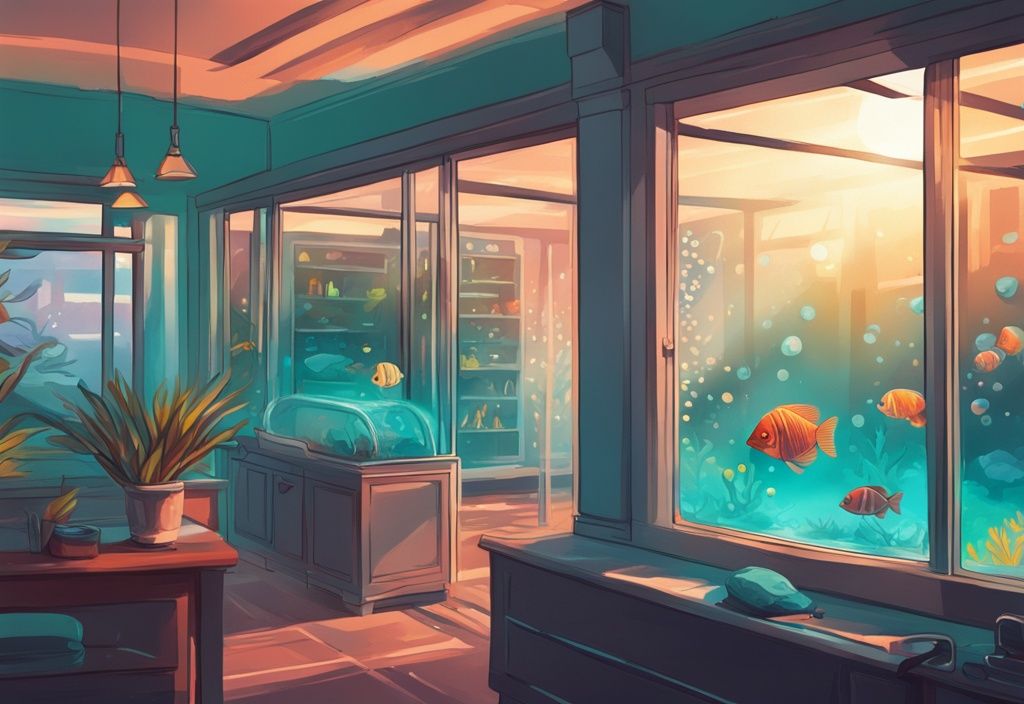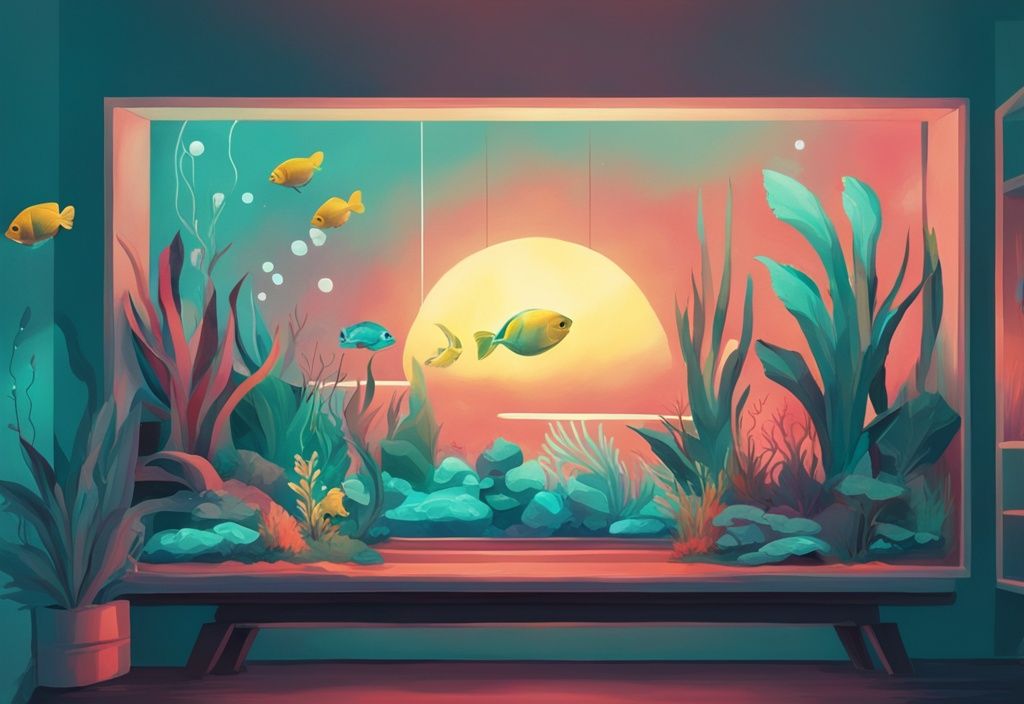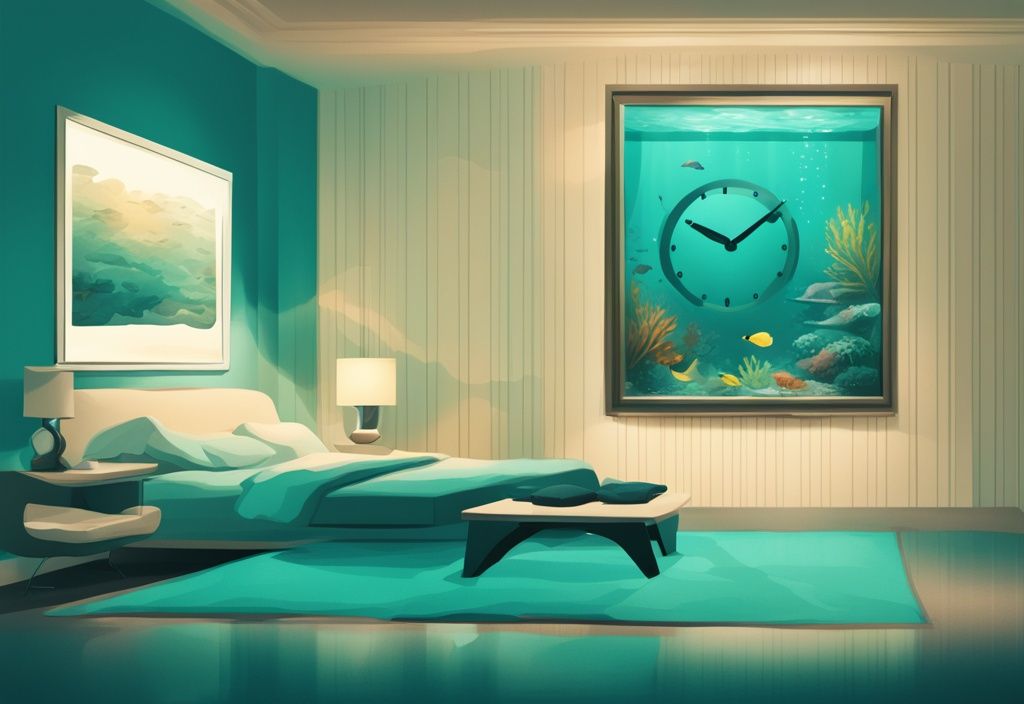Imagine your aquarium as a miniature ocean, where the sun rises and sets in perfect harmony. Proper lighting is not just about aesthetics; it’s the heartbeat of your aquatic world. With over two decades of marine exploration, I’ve seen how the right light can transform a tank into a vibrant ecosystem, much like a coral reef teeming with life. Avoid the pitfalls of erratic schedules and excessive brightness, which can stress your fish and fuel algae growth. Join me as we dive into the art of aquarium lighting, ensuring your underwater garden flourishes with vitality and balance.
Determining the Best Time to Turn On Aquarium Light
Creating a thriving aquatic environment involves understanding the optimal timing for aquarium lighting. Let’s explore how to synchronize your tank’s light schedule with natural cycles, human routines, and seasonal changes to foster a balanced ecosystem.
Emulating Natural Light Cycles
Imagine your aquarium as a mini-ocean, where the sun rises and sets just like in the wild. Turning on the aquarium light in the morning and switching it off in the evening can mimic these natural light cycles. This routine is essential for maintaining the biological rhythms of your aquatic friends. Most tropical fish and plants flourish with around 12 hours of light followed by 12 hours of darkness. This balance not only supports their natural behaviors and feeding patterns but also ensures their overall health.
Aligning with Human Schedules
While it’s vital to emulate natural cycles, aligning your aquarium light schedule with your daily routine can enhance your enjoyment. Adjusting the light to coincide with when you’re home allows for better observation and interaction with your aquatic world. Timers can be your best friend here, automating the process and ensuring consistency. This approach not only benefits the fish but also makes the aquarium a more integral part of your living space.
Considering Seasonal Changes
Just as seasons change, so do natural light cycles. Adjusting your aquarium lighting to reflect these variations can be beneficial. Some aquarists use a “siesta” lighting schedule, turning lights on in the morning, off during midday, and back on in the evening. This method mimics natural patterns and can help manage algae growth by reducing continuous light exposure. Adapting to seasonal changes ensures that your aquarium environment remains stable and healthy throughout the year, providing a more natural setting for fish and plants.
Understanding the Importance of Aquarium Lighting
Aquarium lighting plays a pivotal role in nurturing the health and vitality of fish and plants. While it may seem like a tool for enhancing visual appeal, its significance goes much deeper. In their natural habitats, aquatic life thrives under regular cycles of light and darkness. These cycles are crucial for regulating behavior, feeding habits, and even breeding patterns. By mimicking these natural light cycles in your aquarium, you can help sustain the inherent rhythms of aquatic life, fostering a balanced and thriving ecosystem.
In the wild, fish and plants are accustomed to a consistent pattern of daylight and darkness. This natural rhythm influences their behaviors. For example, light exposure can determine when fish are most active, when they feed, and even when they breed. Aquatic plants, on the other hand, rely on light for photosynthesis, a process essential for their growth and oxygen production. By providing a lighting schedule that mirrors these natural conditions, you ensure that your fish and plants remain healthy and vibrant.
Moreover, understanding the best time to turn on aquarium lights is vital for maintaining these natural rhythms. Typically, it’s recommended to switch on the lights in the morning and turn them off in the evening, aligning with the natural daylight hours. This practice supports the well-being of your aquarium’s inhabitants and enhances the overall enjoyment for viewers. Using timers can automate this process, ensuring a consistent and stress-free environment for your aquatic life.
Remember, creating a harmonious aquarium environment is not just about aesthetics. It’s about nurturing a sustainable ecosystem where every living organism thrives. So, as you ponder the best time to turn on those aquarium lights, consider the natural rhythms you’re replicating and the vibrant life you’re supporting.

The Role of Light in Aquatic Ecosystems
Light is a cornerstone of aquatic ecosystems, crucial for the photosynthesis process in aquatic plants. This magical transformation allows plants to harness light and turn it into energy, vital for their growth and survival. Imagine light as the sun’s gentle whisper to the plants, urging them to thrive. This energy not only supports the plants but also helps them produce oxygen, crafting a perfect home for fish and other aquatic life.
But the story doesn’t end with plants. Light cycles are like the heartbeat of your aquarium, deeply influencing the behavior and health of your fish. Regular periods of light and dark guide fish behavior, shaping their feeding habits and even their romantic endeavors. These cycles establish a natural rhythm, ensuring your fish remain healthy and content. However, sudden lighting changes can be like a surprise plot twist in a novel, causing stress and potential health issues for your fishy friends. Thus, maintaining consistent light cycles is key to nurturing a balanced and thriving aquarium ecosystem.
Impact on Fish and Plant Health
In the world of aquariums, maintaining consistent light cycles is akin to setting a reliable clock for your fish. Imagine if your own day started at random hours—chaos, right? Fish thrive on predictability. For example, certain aquatic creatures, like water fleas living in an aquarium, benefit greatly from a consistent environment. When their lighting is steady, they settle into a routine that mirrors their natural behaviors, such as feeding and resting. This regularity is crucial for their well-being and helps reduce stress.
On the flip side, abrupt changes in lighting can be like a sudden alarm jolting you awake. Such disruptions can stress fish and throw their natural cycles out of balance. To avoid this, it’s wise to make gradual adjustments to light intensity and duration. Think of it as gently dimming the lights at the end of a relaxing evening. By easing fish into new lighting conditions, aquarists can foster a smoother transition, supporting the fish’s adaptability.
Now, let’s talk plants. Light is their lifeline, driving photosynthesis—the magical process where plants convert light into energy. This energy fuels growth and oxygen production, which are essential for the survival of fish and other aquatic life. With the right lighting, plants flourish, creating a harmonious ecosystem that benefits all aquarium inhabitants. It’s like having a well-tended garden, where every leaf and petal contributes to the beauty and balance of the environment.
Determining the Best Time to Turn On Aquarium Light
Creating a balanced and thriving aquatic environment involves understanding the nuances of lighting schedules. By emulating natural light cycles, aligning with human routines, and considering seasonal changes, you can ensure your aquarium remains a vibrant ecosystem.
Emulating Natural Light Cycles
Imagine your aquarium as a tiny slice of the ocean. To keep it thriving, it’s essential to mimic the natural light cycles that your aquatic friends are used to. Turning on the aquarium lights in the morning and switching them off in the evening aligns with the daylight hours familiar to most tropical fish and plants. This practice not only supports their biological rhythms but also encourages healthy behaviors like feeding and breeding.
Typically, providing around 12 hours of light followed by 12 hours of darkness mirrors their natural habitats. This balance ensures that your aquatic inhabitants remain healthy and stress-free. It’s like giving them a little taste of home, right in your living room.
Aligning with Human Schedules
Let’s face it, we all want to enjoy our aquariums when we’re actually home to see them. Aligning the light schedule with your daily routine can enhance the enjoyment of your aquatic display. By adjusting the lighting to coincide with times when you’re around, you can maximize the visual appeal of your aquarium.
Utilizing timers is a brilliant way to automate this process. It ensures that the light schedule remains consistent without you having to lift a finger. This not only simplifies maintenance but also guarantees that your aquarium’s ecosystem stays stable and healthy.

Considering Seasonal Changes
Just like us, aquariums are affected by the changing seasons. Seasonal variations can significantly impact natural light cycles, so it’s important to adjust your aquarium lighting accordingly. Some aquarists opt for a “siesta” lighting schedule, turning the lights on in the morning, off during midday, and back on in the evening.
This approach mimics the natural fluctuations of light throughout the day. It can help manage pesky algae growth while maintaining the well-being of your aquatic life. By being mindful of these seasonal changes, you can ensure that your aquarium remains a vibrant and balanced ecosystem year-round.
Optimal Light Duration for Different Aquarium Types
Understanding the best time to turn on aquarium light is essential for maintaining a healthy and balanced aquatic environment. Different types of aquariums have unique lighting needs, and aligning these with the natural habits of your aquatic life can greatly enhance their well-being.
Freshwater vs. Saltwater Aquariums
When it comes to choosing the best time to turn on aquarium light, the type of aquarium you have plays a significant role. Saltwater aquariums, for example, often demand more intense lighting than freshwater ones. This is because corals and other marine life flourish under bright conditions, much like sunbathers on a sunny beach. Typically, a saltwater setup might need up to 10-12 hours of light each day to mimic the sunlit conditions of a coral reef.
In contrast, freshwater tanks, especially those without live plants, benefit from a more conservative lighting schedule. Limiting light exposure to about 6-8 hours daily can help prevent the overgrowth of algae, a common nuisance in these setups. By syncing the light schedule with natural daylight hours, aquarists can maintain a balanced environment that supports fish health while keeping algae at bay.
Planted vs. Non-Planted Tanks
Planted aquariums have their own set of lighting requirements. These tanks need 8-12 hours of light to promote photosynthesis and healthy plant growth. The best time to turn on aquarium light for these setups is usually in the morning. This timing allows plants to harness energy throughout the day, supporting not only their health but also enhancing the entire ecosystem by providing oxygen and natural filtration.
On the flip side, non-planted tanks can thrive with shorter light durations. By reducing light exposure to around 6-8 hours, you can manage algae growth effectively, as algae tend to thrive in prolonged light conditions. This approach keeps the aquarium visually appealing and healthy for its inhabitants. Adjusting the light schedule to match human activity can also make the aquarium a lively centerpiece in any room, adding joy and vibrancy to your living space.
Adjusting Light Intensity and Duration
Creating the ideal lighting environment in your aquarium is a delicate balance. It’s not just about flipping a switch; it’s about understanding the needs of your aquatic friends and the ecosystem they inhabit. Let’s dive into the nuances of using timers and managing algae growth to ensure your aquarium thrives.
Using Timers for Consistency
Imagine your fish waking up to a sunrise every day, just as you do. Consistent lighting is key to mimicking these natural cycles, and timers are your best friends in achieving this. By automating the light cycle, you can ensure that your aquarium lights turn on and off at the same time each day, aligning with the natural rhythms of aquatic life. This not only reduces the need for manual operation but also provides reliability and peace of mind. Consistent lighting helps establish stable feeding patterns and daily rhythms for your fish, promoting their overall well-being. It’s like setting a clock for your underwater world.
Managing Algae Growth
Ah, algae—the uninvited guest at every aquarist’s party. While a little algae can be beneficial, too much can turn your tank into a green nightmare. To manage algae growth effectively, it’s crucial to adjust both the duration and intensity of the light. Limiting light exposure to the recommended hours based on your aquarium type can prevent excessive algae proliferation. Think of it as setting a curfew for your lights. Additionally, introducing beneficial microorganisms can help compete with algae when the lights are on, creating a balanced ecosystem. By carefully managing light conditions, you can maintain a healthy and visually appealing aquarium environment.
Practical Tips for Managing Aquarium Lighting
Creating a harmonious aquarium environment involves more than just selecting the right fish and plants. Lighting plays a pivotal role in simulating natural habitats and promoting the well-being of your aquatic life. Below, you’ll find strategies to optimize your aquarium lighting schedule, ensuring a thriving underwater ecosystem.

Setting Up a Lighting Schedule
Establishing a regular lighting schedule is vital for maintaining a healthy aquarium. Interestingly, the best time to turn on aquarium lights is in the morning, aligning with the natural daylight cycle. This not only mimics the conditions fish and plants would experience in the wild but also sets a natural rhythm for your tank’s inhabitants. If you’re dealing with algae issues, you might be interested in learning how to manage black algae in your fish tank to maintain a healthy environment.
Consider the specific needs of your aquatic life when setting up your schedule. Tropical fish and plants, for example, generally thrive with about 12 hours of light followed by 12 hours of darkness. Think of it as their version of a balanced work-rest cycle. Using timers can automate this process, ensuring consistency and sparing you from the hassle of manual adjustments. This approach not only supports the well-being of your aquatic life but also enhances the visual appeal of your aquarium during the times you’re most likely to enjoy it.
Implementing a “Siesta” Lighting Strategy
Have you ever considered giving your aquarium a midday nap? The “siesta” lighting strategy can be a clever way to manage lighting, particularly when combating algae growth. This involves turning the lights on in the morning, switching them off during midday, and then turning them back on in the evening. It’s like giving your tank a breather, reducing the risk of algae blooms that thrive under prolonged light exposure.
This strategy mimics the natural light fluctuations found in many aquatic environments, creating a more dynamic and balanced ecosystem. It can stimulate natural behaviors in fish and promote healthier plant growth. By adjusting your lighting in this manner, you’re not only fostering a more sustainable environment but also enhancing the aesthetic and biological aspects of your aquarium.
FAQ
How many hours should aquarium lights be on?
Most aquarium species flourish with 8-12 hours of light each day. It’s like giving them a daily dose of sunshine! However, it’s essential to tweak the duration based on your aquarium’s unique residents and setup. Whether you have a lush planted tank or a simple non-planted one, understanding your aquatic friends’ needs is key.
Can I leave the aquarium light on all night?
Leaving the light on all night is a bit like trying to sleep with the sun glaring in your eyes—uncomfortable and stressful. Fish need a dark period to rest, just like us. Continuous light can mess with their natural sleep patterns, leading to stress and health issues. So, let them enjoy their nighttime peace.
What is the best way to prevent algae growth with lighting?
Ah, the ever-persistent algae! To keep it at bay, limit light exposure to 6-8 hours for non-planted tanks. You might even consider a “siesta” lighting schedule, giving your tank a midday break. Introducing beneficial microorganisms can also help, as they naturally compete with algae, maintaining a harmonious aquarium environment.
Conclusion
Proper aquarium lighting is a cornerstone for fostering a thriving aquatic environment. The health and well-being of both fish and plants are intricately linked to the quality and consistency of light they receive. By mimicking natural light cycles, aquarists can create a balanced ecosystem that supports the natural behaviors and biological rhythms of aquatic life.
Turning on aquarium lights at the best times, typically aligning with daylight hours, emulates the natural conditions found in the wild. Imagine your fish waking up to a gentle sunrise, just like they would in their natural habitat. This approach not only enhances their well-being but also brings out the vibrant colors and lively behaviors that make aquariums so captivating.
Adjusting lighting based on the specific needs of the aquarium’s inhabitants is crucial. For instance, tropical fish and plants generally thrive with about 12 hours of light, while non-planted tanks may require less to prevent algae overgrowth. Think of it as customizing a lighting schedule that suits each unique aquatic community.
Utilizing timers to maintain a consistent lighting schedule reduces manual intervention and ensures that the aquarium’s ecosystem remains stable and healthy. This consistency is key to enhancing the enjoyment of the aquarium, allowing aquarists to appreciate their vibrant aquatic displays while ensuring the well-being of their aquatic companions.
By embracing these lighting strategies, you not only nurture a sustainable and balanced environment but also deepen your connection with the mesmerizing world beneath the water’s surface. Remember, a well-lit aquarium is not just about illumination—it’s about creating a harmonious home for your aquatic friends.
